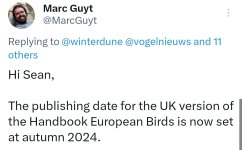James Lidster
Well-known member
Seems very good but pity about the introduced speciees/hybrids, as well as the weird coverage - eastern boundary just cutting through Ukraine and Turkey. Considering the ID challenges in E Turkey, Middle East, North Africa etc which might've benefitted from this book, seems like a great loss. The previous ID handbooks covered all WP
It’s worth mentioning what is included, like 20 pages of wheatears incl seebohm’s and Finsch’s, 30 pages of phylloscs, double page spread on hybrid thrushes, 8 pages on ficedula flycatchers, large intro sections on gulls, raptors, waders, American Black and Cabot’s Terns, Pacific Diver, Slaty-backed, Cape, Glaucous-winged, Heuglin’s gulls, American Horned Lark, Mediterranean Storm Petrel, Atlantic Yellow-nosed Albatross (with a photo of Indian with some text to explain differences), nearly all American passerines that have been recorded in northwest Europe, I say nearly as the empids only get a brief mention, 14 pages of harriers incl Northern, 28 pages of falcons incl Amur, eastern Red-rumped Swallow and Mediterranean Flycatcher. The list goes on and on!
Personally it’s the book (s) I’ve been wanting all my birding life!!
Cheers
James











